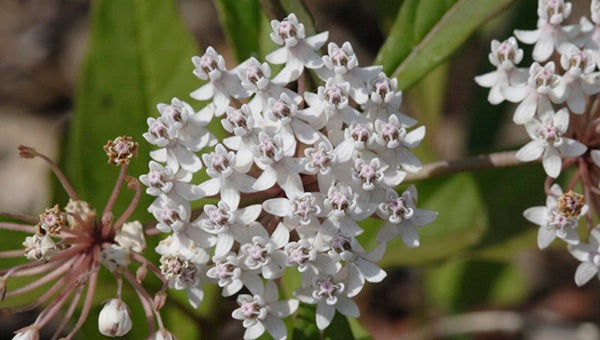Arboretum Paths: Native Mississippi Milkweeds for Monarch Butterflies
Published 7:00 am Wednesday, November 25, 2015

for the butterflies: Aquatic milkweed (Asclepias perennis) is a Mississippi native, found in moist to wet sites in Pearl River County.
Photo by Patricia Drackett
For all of you butterfly gardeners out there – lately we have been hearing some exciting news. The population numbers of monarchs overwintering in Mexico this year just might end up being as much as three times higher than last winter.
Hurricane Patricia’s passage through Mexico in early November thankfully did not have a huge impact on monarch migration. Now, tourists are beginning their own migration to sites in Mexico, such as the Monarch Butterfly Biosphere Reserve, where they can observe these fascinating insects’ arrival.
In the winter of 2012-13, monarch populations reached the lowest point seen in two decades, kicking off the nation-wide concern of scientists and gardeners. Last year, monarch numbers were up almost 70% from the previous year, and many have been anxiously awaiting the predictions for this year.
Websites track migration and provide updates, for example, https://www.learner.org/jnorth/monarch/. Take a spin on your favorite search engine to find video clips and experience an armchair view of what tourists will be experiencing in 360 degrees, as arriving butterflies will roost by the hundreds of thousands in Mexico’s pine and oyamel tree forests.
Monarch populations have been declining due to changes in land management practices and habitat loss, which affects the availability of milkweed, the only host plant of the monarch butterfly. Over the past year, we’ve had many inquiries about the best species of native milkweed (Asclepias) to plant, because many articles and sources recommend choosing native species over non-native milkweed, often the only type available.
Although at the Arboretum we are familiar with several species of native milkweed found in our bog, I wanted to learn more about our Mississippi species from an expert, and contacted Dr. Wayne Morris of Troy University. Dr. Morris is very familiar with the plants found the Picayune area, having assisted Dr. Sidney McDaniel with the plant inventory of the Arboretum’s associated natural areas when he was a student in the 1980’s at Mississippi State University. He quickly provided us with a list of approximately 15 species of milkweed that are found in the state, most suited to growing in our area.
Armed with this list, I then studied USDA range maps and the environmental conditions the species prefer, and noted the species that appeared to have promise for growing in regular garden soil. Other uncommon species could be transplanted or grown from seed and plant into areas replicating the preferred conditions.
Over the past few months I’ve had a lot of fun having discussing milkweed with anyone who will stand still long enough, and am in the process of summarizing, along with Dr. Morris, information on our 15 native species into an easy to read table that will be included in a MSU Extension publication is planned for release in spring 2016. Currently, a poster and draft of the table are available at the Arboretum if you are planning your garden for next year.
In the coming year we will be experimenting with seed I’ve obtained for over half of these species to see which appear to be best suited for home garden use. When the idea arose for this study, the time had passed for harvesting local seed.
At first disappointed, I then realized this was a good example of what a gardener would encounter upon learning there were more potential milkweed species than just the one or two choices of milkweed in garden centers.
The milkweed seed I’ve located hails from numerous sources – some in neighboring states and some a bit farther away. Although milkweed is notoriously finicky we hope some species will stand out as winners. What does this mean for you?
We hope to offer some of these more unusual species in our spring native plant sale! And next year we plan to collect only native Mississippi milkweed seed and to trial as many of these species as possible.
Join us for some festive treats and holiday good cheer at the Arboretum’s annual Holiday Open House celebration on Saturday, December 12, from 10 am to 3 pm. The event will include the unveiling of this winter’s Gallery Exhibit – nature paintings by Gail Sheasby. Gail Sheasby captured our attention last spring at the Arboretum’s Art Show with a stunning acrylic painting entitled “Blue Heron Stalking Dinner.” Mrs. Sheasby hails from the West Bank of New Orleans, LA. Gail has been painting and studying art for over 25 years in oil, acrylic, watercolor and colored pencils. Her favorite subjects to paint and draw, besides her grandchildren, are lovely bayous, oak and cypress trees and wildlife that is so indicative to South Louisiana and Mississippi. Gail is a member of the Greater Picayune Arts Council. Admission is free to all.
The Arboretum is open Wednesdays through Sundays from 9 a.m. to 5 p.m. and located in Picayune, off I-59 Exit 4, at 370 Ridge Road (south of Walmart and adjacent to I-59). Call 601-799-2311 for more information.
By Patricia Drackett





